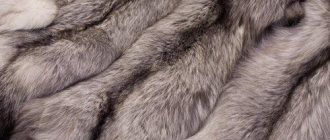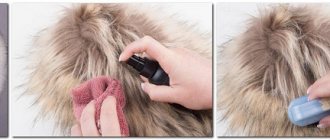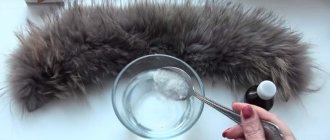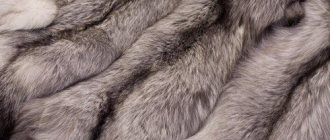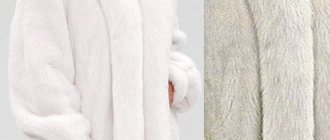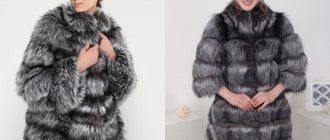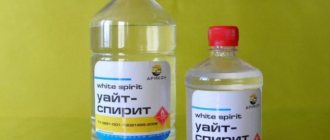A beautiful white fur coat looks great in winter in tandem with sparkling snow. Whether it’s a fluffy snow-white rabbit collar or an elegant silver mink sheepskin coat, they look equally at home in the cold winter. But sooner or later, unfortunately, the fur begins to turn yellow. It loses its impeccable appearance, acquiring the shade of a worn-out item. This, of course, greatly upsets the owners of the fur product.
White fur coat
Some ladies, at the sight of yellowed fur, begin to panic and immediately run to the dry cleaner for help. But you can bleach yellowed fur at home. In addition, the cost of dry cleaning services for fur products is not always justified, and it is worth it to take your product there.
The main causes of yellowing fur
Products made from arctic fox fur may lose their original appearance under the influence of weather conditions. If rain or snow gets on your clothes, your fur coat will become unusable. In addition, the appearance of an unnecessary shade is influenced by:
- heavy dusting of things;
- improper storage;
- absorption of human sweat by the collar and other finishing elements;
- impregnation of products with fatty creams that are intended for daily use.
Lack of regular cleaning and ventilation of the product leads to the appearance of yellow color. An undesirable tint may occur as a result of high humidity in the air where the item of clothing is stored.
Application of blue
If the item cannot be bleached, then it is given a bluish tint. For this purpose, blue has been used for a long time. First, dissolve a few drops of blue in water to obtain a light blue solution. It is poured into a spray bottle and sprayed on white fur or the same as that of a silver fox.
After drying, the product acquires a slightly noticeable bluish tint. It looks like the shimmer of snow, so it doesn’t spoil the appearance of the product. If bluing does not help, then the product is repainted in a darker color. Expensive items are sent to a dry cleaner, where a specialist will clean or paint them at your request.
How to clean natural fur from yellowness using folk remedies
The procedure for returning such products to their original appearance involves the use of dry products. Water can be used only in minimal quantities and in the most extreme cases. Natural fur will lose its properties after washing and the item will be deformed.
Using hydrogen peroxide
The main component has long proven itself to be an excellent bleach. There are several ways to remove unnecessary color from fur:
- You need to take the same amount of the specified substance and water, mix them, and apply the resulting composition evenly to the damaged surface.
- You need to take hydrogen peroxide and starch (you can use talc), the ratio of ingredients is 1:1. Mix the ingredients thoroughly, apply to the desired surface and leave until dry. Remove any remaining product with a soft bristle brush.
A mixture of 1 tbsp will help remove the yellowness of fur from a silver fox. l. main component and 1 tsp. ammonia. Both substances must be mixed in 250 ml of water, and the resulting solution should be sprayed onto the desired area using a spray bottle.
Using baking soda and rubbing alcohol
Baking soda or any other sorbent will bleach fur at home in one procedure. In addition to the white substance, you can use talc or starch. The order of actions is as follows:
- Remove dirt from the area being cleaned and shake out the item well.
- Place the product on a flat surface or hang it on a hanger.
- Apply the selected product with gentle movements to the item of clothing.
- Use a soft brush to move along the pile in the direction of growth.
- After the procedure, shake out the item thoroughly.
A mixture of 100 g of medical alcohol and 10 g of any sorbent will help to bleach the yellowness of arctic fox fur. The substances must be brought to a homogeneous consistency, after which the resulting product is applied to the desired surface. Remains of the cleaner are removed with a damp towel, the product is wiped with a dry cloth and hung out to dry.
Using vinegar
A solution of 9% will help not only bleach yellowed fur, but also restore freshness and shine to the product. The item should be laid out on a flat surface, the cleaner should be applied to the desired area, and the clothes should be taken out to dry. Vinegar is diluted with water or lemon juice, the ratio of components is taken 1:1. Any of the solutions is applied to the product in the direction of hair growth.
Cleaning with shampoo and dish soap
They will bleach yellowed fur at home in 10-15 minutes. You need to take one part of any of the indicated components, the same amount of starch and washing powder. Mix the ingredients until smooth, apply to the product, and after the time has elapsed, clean the area with a damp towel. A solution of 1 tsp will help remove yellowness from silver fox fur. any kitchen utensil cleaner and 1 tsp. ammonia. Both substances should be mixed in 2 glasses of water, the resulting solution should be applied to the contaminated area, and the residue should be washed off with a damp towel.
Is it possible to wash arctic fox fur?
The Arctic fox has long hair, so it is extremely sensitive and fastidious to care for. As practice shows, any mistakes when cleaning and further drying such a collar can lead to damage to the item. Therefore, the use of hand and machine washing in this case is unacceptable. You can restore a presentable appearance to an arctic fox product at home by cleaning it dry or wet.
Important! The collar should not be washed, as this will cause it to lose its shine and the pile to become brittle and tangled.
Also, during wet cleaning, you need to make sure that the base of the arctic fox product does not get too wet, as otherwise it may shrink when drying. However, slight moisture is allowed. The main thing is to thoroughly dry the fox collar in natural conditions without using heating devices or a hair dryer.
How to clean faux fur from yellowness
Artificial fur, unlike natural fur, can be hand washed. The methods described below can only be used if there is no fabric base underneath the product. If available, it is better to turn to professionals for help.
Using glycerin
To remove yellowness from fur, the main component must be mixed with water, the ratio of ingredients is 1:1. The product is cleaned with a soft bristle brush. Before the procedure, the yellowed item must be cleaned of dirt and dust.
With the help of blue
A popular household product will help eliminate unnecessary color stains and return white fur to its original appearance. You need to take several crystals of this substance and dilute them in warm water. The latter should turn out to be a delicate blue shade. Treat the required surface with the resulting solution, dry the item, and comb the pile with a special brush.
Why does fur turn yellow?
Natural light fur takes on a yellow tint with age. Over time, dead hair loses its white pigment. Sunlight and precipitation contribute to rapid yellowing. Individual spots may appear from sweat and grease. First, the guard hairs turn yellow, and then the undercoat.
Yellowness appears not only on uniformly white fur. Sable and silver fox, whose fur is only partly white, turn yellow.
Faux fur also turns yellow from prolonged wear. Gradually, dust, dirty sediments, cosmetics, and sweat are absorbed into the villi. Dirt turns the surface yellow or grayish. Therefore, it is important to remove dirt in a timely manner and comb the fur regularly.
Tips for storing and caring for fur
You can increase the service life of these delicate products only if you follow the basic rules of their operation. For this, experts recommend:
- Hang blue mink items in a closet in a linen bag. It is strictly forbidden to use plastic bags; the product will begin to fade and the pile will become brittle.
- Store fur coats in a dry, cool, dark place. High temperatures, humidity and sunlight cause lint to pill and deform the garment.
- Fur clothing should be hung separately from items made from other materials, as natural fabrics quickly and permanently absorb any foreign odors.
- In the fur item and the room where it is stored, put products that will protect the product from moths. These can be either bags with special herbs or professional preparations (for example, Antimol).
- Avoid getting cosmetics on fur items. The clothes will turn red, become shiny, and it will be impossible to return the item to its original appearance.
- When traveling, do not carry products in suitcases or bags.
- Once every 30 days, ventilate the fur coat and its storage area. The procedure will help prevent the appearance of moths and other harmful insects.
- Do not dry fur items with heating devices. If water or snow gets on them, the product should dry naturally.
- If you regularly wear a mouton fur coat, clean it once a year; if the item is used infrequently, then it is allowed once every 2 years.
Before storing a wardrobe item, you need to clean it with soapy water. Housewives advise using Biofur soap. It must be diluted with water in a 1:1 ratio, apply the resulting product to the surface of the product, after 5 minutes, rinse off the remaining substance with a damp towel. Dry the fur coat naturally, hang it on a hanger and put it in a suitable room.
Cleaning with sawdust
At home, you can clean light or dark fur items using sawdust. Buy clean sawdust from deciduous wood (linden, birch, aspen, etc.). Sawdust from coniferous trees cannot be used, as they contain resins, which can cause the fibers to stick together. Moisten the sawdust with alcohol and scatter it over the fur. Rub lightly with your hands and add another portion. So you need to go over the entire collar, hat or fur coat, and then comb out the sawdust with a comb.
Instead of alcohol, sawdust is moistened with gasoline, but it is necessary to use purified aviation gasoline so that it does not contain foreign impurities.
Sawdust absorbs dirt, grease and makes the fur lighter. This cleaning especially helps in those places where the product comes into contact with the neck and face. The method is used to refresh the collar of an arctic fox or silver fox.
How to wash sheepskin products in an automatic machine?
If the dimensions (more than 50 cm on at least one side) and the degree of contamination of the product do not allow manual cleaning, it is carried out using a washing machine. To properly wash sheepskin using this method, you need to consider three points:
- Special detergent.
- Suitable temperature.
- Correct mode.
It is important that the detergent is in the form of a gel and not a powder, does not contain chlorine or other aggressive components, and is specially designed for wool and delicate materials. These popular products include:
| Product | Properties |
| "Weasel" | Soft gel for gentle cleansing of delicate items. It is economical in consumption. |
| "Dreft" (wool) | Gel for automatic washing. Gives a pleasant aroma, fights loss of softness, static electricity. |
| "Help" (delicate) | Special product for machine washing fur. Ensures preservation of the shape, color, and structure of the pile. |
Gels are used in accordance with the instructions on the label if there is a sign on the product tag that allows automatic cleaning in the machine. The item should fit freely in the drum to avoid unnecessary friction. It should first be checked for the absence of foreign objects in the pockets, and fastened with all buttons (zippers, buttons, fasteners). A good additional measure of protection would be a special washing bag that protects the lint.
Natural sheepskin deteriorates when exposed to high temperatures. Being in very hot water will lead to hair loss, shrinkage, deformation, and color change. The optimal temperature in the machine is 30-40°C with an average washing time.
Acceptable modes for sheepskin fur:
- Delicate. Designed for capricious materials subject to shrinkage, shape changes and shedding.
- Wool. Mode with a minimum of heat, speed and no push-ups. It's basically a long soak with gentle turning.
- Handwash. Soft program with rotation up to 600 rpm, excluding pre-wash and additional rinsing.
- Silk. Delicate mode, eliminating strong heat and intense friction. Suitable even for dyed sheepskin.
Causes of yellowness
The main reasons why fur loses its original appearance:
- Products made from fur don’t like getting water on them, and it’s not easy to predict what the weather will be like. Rain and snow damage the attractiveness of the product.
- Accumulation of dust on the surface of the pile, especially if you often forget about proper storage of the product and do not regularly ventilate it.
- Secretions of human sweat glands, which are quite well absorbed by a fur product.
How to dry it properly?
Wet sheepskin has a lot of weight, which makes it difficult to gently wring it out with your hands. The automatic spin mode is too aggressive and can ruin the material. You need to let it drain naturally in a machine drum or in a bathtub. Dry sheep fur at room temperature in a horizontal position. It is laid out on terry towels, changing them to dry ones as they get wet. Vertical drying is prohibited; the only possible way is to place clothes on a hanger.
To tidy up a sheepskin coat or other expensive item, it is better to use a special service. Professional dry cleaning guarantees excellent results, preservation of all properties without the risk of damage (shedding, shrinkage, tangling and lint loss).
Removing yellowness with starch
What to do if the white mink has turned yellow, how to bleach it without leaving the house using improvised means? In this case, ordinary starch will help, and if you can’t find it, then talc or semolina.
The whole process will look like this:
- You need to take a white sheet or any clean, colorless cloth and soak it in cold water.
- Wring out the fabric well and wrap the white item in it.
- Walk over the entire surface, picking the fur through the fabric. A damp cloth will do the trick and some of the dust and dirt will remain on it.
- After this, let the fur coat dry for some time.
- Place the fur coat on the floor and treat with starch.
- Rub the fur with your hands, trying to grab every corner of the product.
- Allow the absorbent substance to penetrate deeper, then comb it out with a brush.
You can also use a vacuum cleaner if it has a low setting. For short fur, movements should be against their growth, for long fur - in the direction. Starch is only suitable for the Arctic fox; on dark fur, for example, silver fox, it will get stuck among the pile and it will be almost impossible to comb it out.


